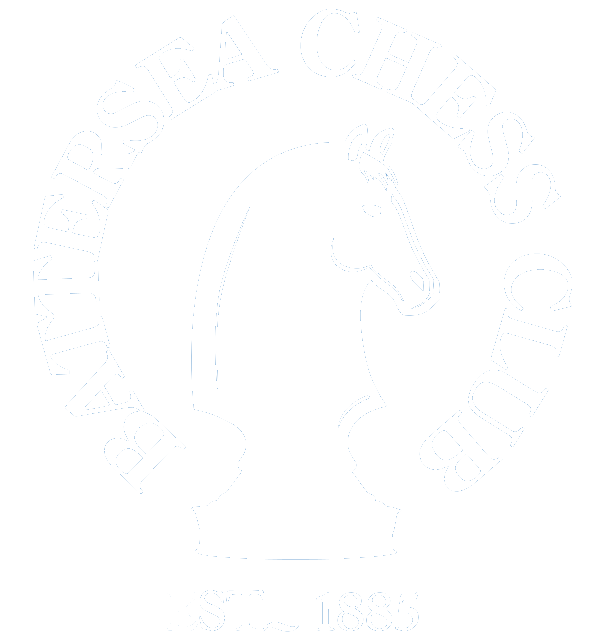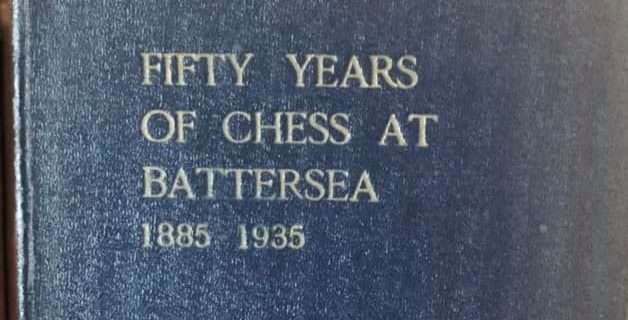Battersea Chess Club has been continuously in existence since 1885, surviving and thriving from the reign of Queen Victoria through two world wars and into the 21st century.
Our historical records, including committee minutes and newspaper cuttings, are kept at the Lavender Hill Library, just a stone’s throw from one of our former venues and a short walk from our current venue.
In recent years we’ve lost our way a bit when it comes to recording our history. However, that was not always the case. In 1935, on our 50th anniversary, an early history of the club was produced – see ‘Fifty Years of Chess at Battersea’ below. In 1955 the club celebrated its 70 anniversary.
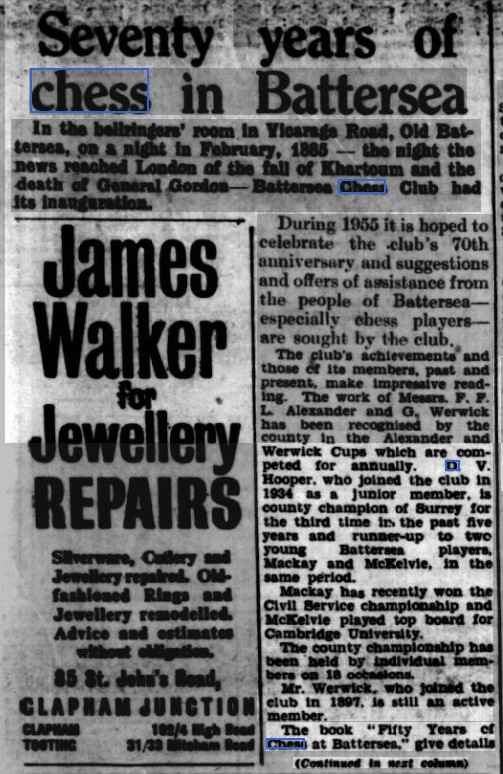
Over the years Battersea has had a number of top players playing for it, including in their youth the well-known chess journalists Grandmaster Raymond Keene, famously the second Englishman to achieve the GM title, and International Master Bill Hartston. Perhaps the strongest Battersea player of his time was Isidor Arthur Gunsberg, the Hungarian chess player, who lived nearby for a while and was best known for narrowly losing the 1891 World Chess Championship match to Wilhelm Steinitz.
More recently the club has seen three-time British Champion GM David Howell along with GM Simon Williams have played for the club. In 2019, IM Adam Taylor earned his title.
A particularly longstanding member was the late
Other former players of note for their achievements outside chess were the inventor of VAT, the late Frank Parr

Our current longest-serving player is Paul Stokes, who has played for the club for over 40 years. Charles Cronin, Bill Drennan, Arnold Hunt, Joe Skielnik, Emil Todorow and David Wigg have also been at the club for over a quarter of a century and the highly-rated Tony Ashby has returned in recent years to the club he grew up with.
Battersea has won the London Chess League, of which it was
In 2015, Battersea Chess Club returned to the London League First Division for the first time in many years and currently has three young players who played in the 2015 British Championship, Ali Hill, Chris Beckett
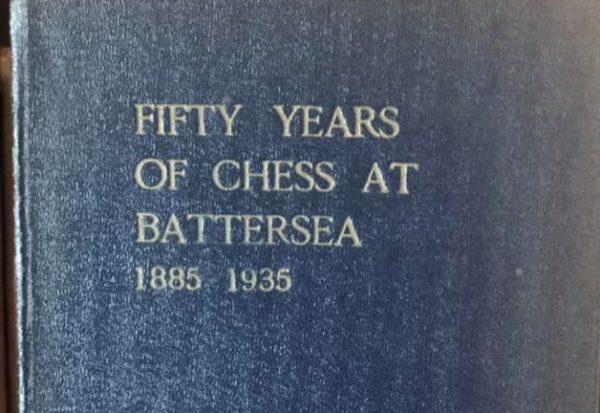
Fifty Years of Chess at Battersea
Edited and Compiled by L. C. Birch, 1935
INTRODUCTION

It is reported that the Rt. Hon. John Burns, when watching Len Holland make one of his delightful centuries for Surrey at the Oval, said “At last something good has come out of Battersea.”
This may or may not be true, but, if true, then the celebrated Labour M.P. cannot have known anything of the Battersea Chess Club.
It must have been flourishing at the time, it has been flourishing ever since, it is flourishing now, and it will long continue to flourish because of the excellent foundations so well and truly laid by W. P. Plummer and G. Wernick.
Amongst my very earliest recollections of London League Chess, which go back nearly 40 years, is one of a very jolly man, with masses of black curly hair, who was in charge of the team from Battersea. The masses of black curly hair have now changed to masses of grey curly hair, just as surely as my own locks have departed altogether – but W. P. Plummer still represents Battersea, and still holds the same honoured post in their counsels.
I must have played against Battersea nearly thirty times, and on many of these occasions have played G. Wernick and never have I encountered a more pleasant or more sporting opponent. What our scores are I do not know, but I can honestly say that I would as soon meet him as any player I have ever met over the chess board. The Battersea Club is to be congratulated on possessing two such stalwarts.
I am tempted, in writing this introduction, to make comparisons between the Battersea Club and my own Club, the Athenaeum. We can boast seniority at any rate, if that be a matter for boasting, but I marvel at the completeness and thoroughness of the Battersea records, which leave ours miles behind. It almost seems that their very first secretary and treasurer and other officers, in recording their activities so meticulously, were actually preparing for this account of the first 50 years of the Club’s existence.
Battersea is one of the few remaining Clubs which uphold local tradition. When playing against them you know you are playing a Battersea man, and their team provides a striking contrast to some of the heterogeneous collections of recruits from all parts with no bond of local patriotism, which constitute some of the teams in the League. If the Clubs could only return to a definite geographical qualification the spirit of the League competition would be immeasurably improved.
Last year, speaking at the 50th anniversary of the Ealing Chess Club, Dr. Lasker said that he felt honoured to be present at their jubilee meeting and hoped to be present at their centenary. Similarly I am flattered at being invited to write this Introduction, but regret that my other engagements will prevent me writing my congratulations to the Battersea Club on achieving its hundredth year; but if only Mr. Plummer and Mr. Wernick will stick to the Club, that pleasant task is in store for some one.
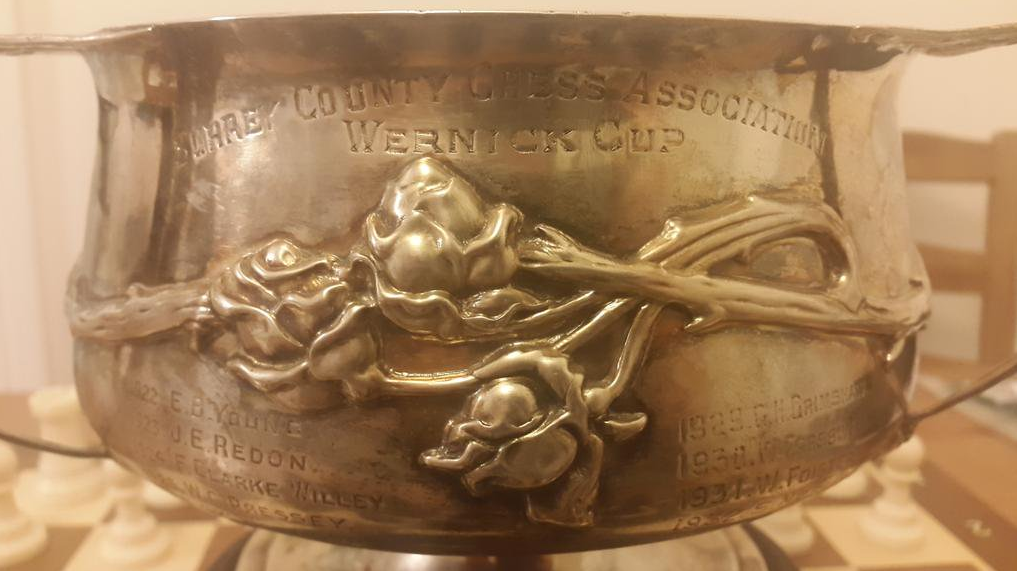
This account of their first fifty years, a record of both successful endeavour and of actual performance, is one of the most entertaining Chess publications I have ever read. It pays due tribute to the officers of the Club, who can only have achieved such a remarkable measure of success with an enthusiastic and appreciative following. They have evidently been well favoured in this way. The book will thus stand as a permanent record not only of the loyal work of these officials, but also of loyal support from the rank and file of the Club membership. It is a monument of application and research, and in this respect unstinted praise is due to Mr. L. C. Birch, the Editor and compiler.
- H. WATTS. September, 1935.
PART ONE
A SHORT SURVEY OF THE HISTORY OF THE BATTERSEA CHESS CLUB.
By L. C. Birch
I. THE FOUNDATIONS
The Battersea Chess Club was founded on 5th February. 1885. at the BeIlringers’ Room, Vicarage Road, Old Battersea. The room was so named because church ringers used it. And handbell ringers practised there an art that was then fashionable. Across the road-formerly known as Vicarage Wharf flows the Thames, where barges drift down with the ebbing tide, where ghostly tugs toot as they pass in winter fogs, and where gulls circle in flight or stalk over the mud the whole year round. This quiet backwater away from the main stream of London traffic has lost its former old world charm. Where a solid embankment now stands, racing shells and rowing boats put out from the Battersea beach fifty years ago, as at Putney to-day. The Vicarage House School and the Bellringers’ Room have been long since demolished. Blocks of five storey L.C.C. flats, erected in 1933 on the adjacent site, replace the Battersea Training College, famous for nearly a century as the first college in England for training elementary school teachers. Battersea Vicarage and the Vicarage House, with its tall iron Railings, numbers 9 and 7 respectively, alone are unchanged and give a glimpse of former glory. Bolingbroke, statesman in Queen Anne’s reign, the greatest of all the St. John family which held the manor of Battersea for centuries, spent the last years of his life here after his exile. Near by, in St. Mary’s Church, north of Battersea Square, Bolingbroke lies interred, sleeping uneasily amid modern bustle. Artists in the past loved to sketch the view of St. Mary’s Church and Old Battersea from the Chelsea side of the river; aquatints, etchings, woodcuts, water and oil paintings abound. Today the rising tide of Industrialism and Modernism – huge factories, iron-roofed sheds, ugly warehouses and modern barrack-like flats has almost submerged the few buildings remaining from the 18th century. In this area the Battersea Club began its existence.
How a chess circle became a club is best told by Mr. W. P. Plummer, who describes the change in a “Review of the Club,” written in 1905. “About the beginning of 1885 young and enthusiastic Chess players found it somewhat difficult to practise their favourite recreation; hence the idea of a small society for mutual improvement in the game. Two of these enthusiasts took up the notion with avidity, and to this end communicated their desire to the Rev. E. L. Wise, M.A., the then Head Curate of St. Mary’s, Battersea, who kindly intimated that if a Club were started he would broach the subject to the Vicar, Canon J. Erskine Clarke, M.A., with the view of obtaining a room at the Vicarage House School for the purpose of meeting. This was done, and the Vicar at once placed a room, known as the Bellringers’ Room, at their disposal for practice, and a large hall for matches. Messrs. C. Gough and W. P. Plummer, the two leading spirits above referred to, then called a meeting and a small number of supporters attended. The details were rapidly arranged and a Club, called the Bolingbroke Chess Club, was started.

The membership for the first season numbered about 14, with a subscription of 1/6 per annum. Canon Clarke accepted the office of President, and the first Secretary was Mr. W. P. Plummer (right).
“The next season and the three following seasons saw the Rev. E. L. Wise acting as President; the membership was augmented and a small match-list arranged. The first match played was against Balham, and ended in the defeat of the new Club.
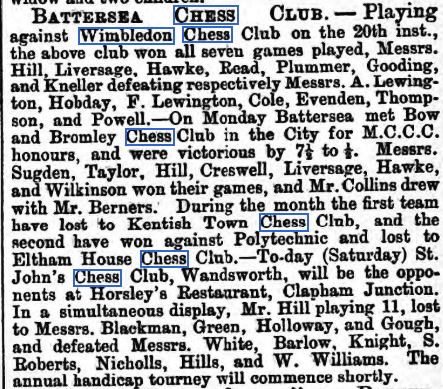
”In 1888 the headquarters of the Club were shifted to a more central position at ‘Horsley’s,” afterwards known as the Imperial Restaurant, at the corner of Ilminster Gardens, Lavender Hill.
“The membership of the Club still increasing in 1891, another move was made to 110, Battersea Rise, which address has ever since been identified with the Club”
The last statement is still true, and with the change of 1891 the Club finished the first stage of its development; the foundations were completed. The migration to the Clapham Junction district had made the appellation “Bolingbroke” inappropriate. The name-at first “Bolingbroke,” then Battersea “Bolingbroke” Chess Club-was changed in 1888 to the Battersea Chess Club
II. EXPANSION
The trend of the decade after 1891 was broadly twofold: a steady expansion, and the making of rules and customs, which hardened into the club’s set way. Of the numerous statistics and facts that might be quoted to show this expansion the following must suffice. The membership remained steady throughout the decade at about 85, a hundred being reached in the peak year of 1895. A glance at the fixture lists shows the steady development. For instance, it will be found that the 1891 fixture card gives a list of 30 matches, mostly of 6 or 8 boards, compared with the 1901 card of 28 matches, mostly of 12 or 20 boards. The most ambitious fixture was the annual Rochester match (usually a 20-board match), which began in 1894 and continued for 16 years. Matches with Hastings were also attempted. The first simultaneous display to appear on the fixture lists was given by I. Gunsberg (a member of the Club at the time) at the Railway Tavern, on 19th September, 1891, but before this several displays had been given by club members and other players. The earliest display recorded was given by F Lee at the Crichton Hall, over 25 boards, on 13th May, 1889. During the decade simultaneous displays were given by Rev.J. F. Sugden, Messrs. H. H. Cole, H. W. Van Lennep, Lucien Serraillier, J. H. Taylor, H. S. Barlow and Evan Creswell. For many years A. Curnock gave an annual blindfold display over 6 boards. The Club entered the Metropolitan Chess Tourney in 1889 won the “B” Division in 1889-90, and played In the “A” division from 1895. These facts, which could easily be multiplied, though dull, mark a steady and important growth.
On the other hand, the process of custom-making makes far more lively reading. It reveals the reasons for many rules which the chess player to-day accepts as self-evident axioms, but which are in fact the solutions fashioned by an older generation to problems now forgotten. For instance, the “Chess Player’s Chronicle” (1st March, 1881) preaches at great length on “touch and move,” and describes a player touching and displacing every piece before making a move – unbelievable to anyone who has not taught the game to schoolboys or novices. The Battersea Club faced with the same problem, put among its tournament rules, year after year in the nineties, a rule that strict “touch and move” must, be insisted upon. Again, handicap play was still a passion t the time. The committee spent evenings attempting to classify players fairly, Since the chief tournament was a handicap one in which every player’s chance was supposed to be equal : handicap schemes to achieve this equality were changed practically every season.
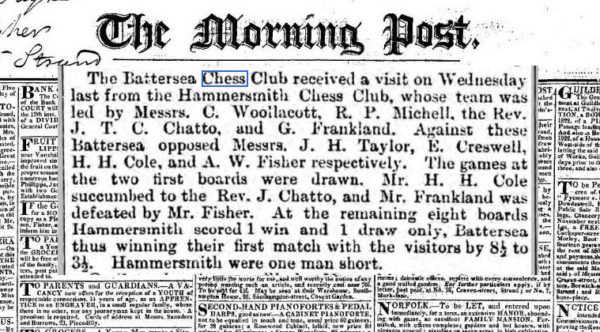
Individual vanity proved a formidable obstacle. A curious example of this was a reluctance to allow any member to style himself “Champion” of the Club. In 1895 a proposal that the winner of the winter handicap tournament should be called champion of the Club was narrowly defeated by one vote. A championship tournament was not held until 1904.
Some interesting glimpses of the past may be gleaned from the old minute books. The committee in 1893 recommended ” a ‘quick’ rather than a ‘slow ‘ line of play” to members, a recommendation which is mysterious. The first mention of clocks is in a minute of 1892, when “the clocks from Fattorini and Sons having arrived.” the committee decided on a time limit of 20 moves an hour. Perhaps the most human reference of all is to Queen Victoria’s funeral “falling on a club night, and the day being observed generally as a day of mourning, considerable doubt existed whether games fixed for play would be postponed. Consequently, many competitors were absent.”
III. MATURITY
From 190I to 19I4 the Club followed the even tenor of its way ; match lists show little change. In the “A” Division of the London League, Battersea finished about mid-way for several seasons, until a decline set in after 1907. The most outstanding event was a simultaneous display by Dr. Lasker, then World’s Champion, given at the Club in 1908. For a short time the Club had the only patrons of its long career. In 1905, Sir Wyke Bayliss became the Club’s first patron, and on his death, soon afterwards, Percy M. Thornton. M.P., was patron for a short time.

In the years 1902-07, and again in 1909-13, the Club had as secretary H. C. L. Hanne, a strong personality and a well known public figure in Battersea. Because of his prominent position, he brought to the Club honour among Battersea folk. He was endeared to those Battersea members who were his intimate friends by his genial nature and ready wit. His minute books show many touches of humour, where the formal report did not repress his virile nature. One instance among many occurs after an evening spent at a committee meeting which dragged on its interminable business till near midnight. He writes : “The hour waxing late, and members beginning to show desires of returning to their various homes, it was resolved to defer discussion of this matter till the next meeting.”
During the decade before the War a gradual decline in membership, serious after 1910, took place. until by September, 1914, it had fallen to 26. The reasons for this “retrograde tendency” – as Hanne calls it as early as 1907, when the membership was 48 – are obscure. Several factors might have been contributory causes: a slightly increased subscription in 1906, trade depression and unemployment from 1906, several changes in the Club’s officers between 1906-1914, and perhaps Chess itself was at a low ebb in England. Whatever the explanation is, the effect of reduced membership can be seen in a committee proposal in February, 1908, to withdraw from the London League, which was defeated. Another proposal in 1908 was that the Battersea Club should amalgamate with the Westminster Chess Club, but before the matter was fully discussed the Westminster Club amalgamated with “another Club,” namely the Athenaeum.
IV. THE WAR

On the dark days of the War we prefer not to dwell. Chess immediately fell into decay. The introduction of earlier closing hours for licensed premises in October, 1914, led to a new departure. By arrangement the Club continued its meetings after the normal hours of opening, and this practice has been followed ever since.
Matches began earlier. The Surrey Trophy and South London League Competitions expired in 1916, but the London League continued as a friendly competition until 1917. War-time conditions, with ill-lighted streets, fear of air raids, poor transport facilities, may be seen in the rules of play (1917): – “Players are allowed 30 minutes’ grace without time counting against them, but games forfeited by players not present at 7.30 p.m. The Time Limit is 30 moves in the first hour, and then 6 moves every quarter of an hour. Play stops at 9.30p.m.” Even in the fourth year of the War, friendly 8-board matches were played with Hampstead, Metropolitan, Islington and Bohemians. It is a tribute to certain stalwarts – particularly C. Wernick (left), H. W. Sansom. and S. P. Lees – that the club continued to exist.
One bright spot in these gloomy days is the story of the Club’s present Handicap Cup. Mr. Wernick. who had won the previous cup outright in 1913-14, happened to mention in the course of conversation with another member, Lieut. S. F. Brittain-Smith, that a new cup would have to be bought, and thought no more about it. To his surprise Brittain-Smith, who had said nothing, appeared at the Club shortly afterwards and handed to the Club’s officers the present handsome Cup, which he had bought as a gift.
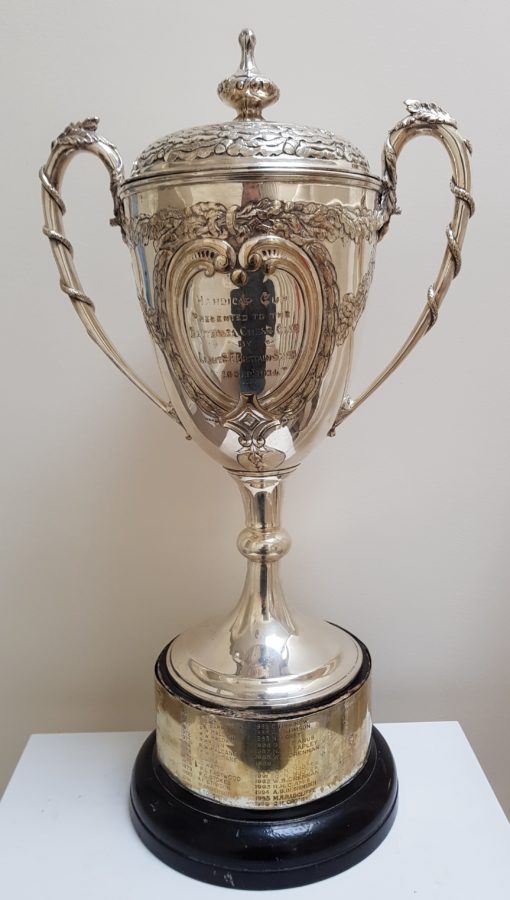
Probably with some premonition or fear of his fate, Brittain-Smith chose in this generous way to end a fifteen-year-old connection with the Club, for he died of dysentery in 1917 in the East Mediterranean.
V. POST WAR YEARS
With peace the Club membership went up rapidly. Old members returned and new members joined. The influx began in 1920 and continued until 1922, when one estimate gave the total number as 119. This swollen membership forced the Club to consider the problem of finding new headquarters, since the room then occupied at the Railway Tavern was small. At least half-a-dozen proposals, including the purchase of a house, were carefully considered and rejected. For some years, however, an extra meeting each week during the winter months was held at Walshe House, Clapham Common (1921-22 and 1924-26) and at the Temperance Billiard Hall, Wandsworth Road (1922-24).
- D. Yates for many years gave a simultaneous display annually. Other displays have been given by G. Maroczy and J. Mieses, and of those by amateurs, several by J. Butland were the most brilliant. The match lists, compared with the pre-war standard, show a considerable extension. From 1921-22 the fixture list reached approximately 60 matches a season for several years, a record of 64 being reached in 1925-26. During 1921-22 Battersea played Kent over 50 boards at the Strathblane Hall, Battersea, and an invitation to play a 100-board match was declined by the County. More recently, in the 1931-32 season, a team representing the Southampton League visited Battersea, and retired well beaten by 12 ½ -3 ½
Certain changes of taste may be noted. Many successful Whist Drives were held during these years at the Billiard Hall and Walshe House, but Smoking Concerts, very popular in the twenty years before the War, received little support. Charabanc outings for the purpose of playing matches sprang into popularity in the years immediately after the War. Caterham and Guildford, among other places, were visited in this way. The place as an annual outing held by the Rochester fixture between 1894 and 1910, has been taken since 1922 by an annual summer match with the Christchurch Club, Brighton, which has been combined on many occasions with a bowls match in the afternoon at Hove. The return fixtures have been played at Battersea in the winter. In 1928 the Club had a sufficient number of young members to try a novel and successful experiment of raising a cricket team. Opposing sides waited in a suspense, which was a mixture of mirth and astonishment, to see the “Battersea Chess Cricketers,” as the team was called, turn out. Many a cricketer, who had expected to amuse himself by bowling underhand to eleven portly greybeards reminiscent of W. G. Grace, was sadly disappointed.
It has been part of the Club’s policy for the last fifteen years to encourage junior members. In 1924 a special tournament for junior members was instituted and a “Junior Cup” purchased. The first Boy Champion of the Club was H. Williams, and since then the Cup has been contested annually, with the exception of 1930-32, when junior members were few. This boys’ competition is, to the best of our knowledge, the only one of its kind in London Clubs, and perhaps in England.
Two recent examples of devoted service to the Club must be recorded. M. S. Hadyn Thomas, whilst secretary, spent many hours preparing a record book containing annual lists of members, and a card index of all persons who had at any time been members of the Club. These records are as perfect as it has been possible to make them, and form valuable additions to the Club’s archives. In 1930, A. H. Butterworth presented to the Club a “beautiful framed photograph of the Club Championship Trophy done by himself,” the names of the winners being inscribed around the border. A. H. Butterworth, who joined the club in 1893, was an active member for forty years, and served the Club as Treasurer (1908-14) and later as assistant match captain. His death in February, 1935, our Jubilee month, was deeply regretted by the members, but his gift hanging over the notice board in the Club room is a fitting reminder of a constantly cheerful man, whose outspoken good nature made him very popular.
VI. BATTERSEA’S PART IN CHESS
No history of the Battersea Club, however short, would be complete without some attempt to assess the part it has played in the development of chess in London and Surrey. Before examining details, it must be remembered in passing that scores of players, after learning their chess or developing their chess strength at Battersea, have been after departure towers of strength to clubs in all parts of the world; whilst a few have founded new clubs in other districts, as-to quote but two examples – F. Bartlett and A. Yates, founders of the Egham and Staines and West Norwood Clubs respectively.
Some mention of the Club’s activity in the London League from the time of its first entry in 1889 has already been made in the earlier part of this survey. Since the War, Battersea has supported the League to the fullest extent possible. From 1922, with the exception of one season, 1928–29, Battersea has run three teams in the League year after year – a feat that no other club can boast; indeed, less than half-a-dozen clubs have continuously entered two teams! The result of these sustained endeavours is that the highest honours in this competition have at length been gained. The League Championship has been won in 1929-30 and 1934-35, and in 1930-31 and 1932-33 Battersea tied with Hampstead and Brixton respectively for first place, the tie matches being lost. Finally, the much coveted Eastman Cup was won in 1933-34.
Still greater has been Battersea’s part in Surrey Chess. The County Association has found in the Battersea Club an inexhaustible supply of players and officials. Battersea players, weak and strong, attending county matches by the score, have helped to win 50 or more a side matches, and have supported the summer competitions which are the envy of other counties. It is surprising to find that no Battersea member has won the County Championship from 1925, when T. H. Robertson gained the honour, until 1935, when F. Parr was successful, although in the meantime Battersea has won the Surrey Trophy eight times and the Alexander Cup four times. In all, Battersea members have held the County Championship on fourteen occasions since E. Creswell first gained the honour in 1894.
Again, during the last twenty years the club has supplied the County with many officials. F. F. L. Alexander, treasurer since 1919, was formerly secretary as well (1919-26). E. G. R. Cordingley, the present secretary, had as predecessors in that office I. P. Jenkins (1925-29) and C. H. Jago (1929-31), also Battersea members. Of County Match Captains, H. A. Pound, the present official. G. Wernick (1913-21 and 1925 -29) and F. R Gibson (1929-32), all mastered the difficulties of match captaincy by leading Battersea teams to victory. Yet, as one so often discovers, all these Battersea members have but followed the track left by W. P. Plummer, who was on the Surrey Committee from 1885, was secretary 1892-95, and who helped to stir the County out of its then moribund condition. The work of Messrs. Alexander and Wernick for the County has been fittingly recognised in the Cups, annually competed for, and named after them.
Finally – as if the foregoing were not a sufficient proof of vigour -Battersea helped to found the British Chess Federation. Its delegate, W. P. Plummer, attended the preliminary meetings held in 1903, and he acted as a London delegate until his resignation in 1914. Later, G. Wernick represented the London League; and in recent years F. F. L. Alexander has represented the British Chess Problem Society on the B.C.F. Executive Committee.
VII. REASONS FOR SURVIVAL
In conclusion, one question remains to be answered: Why has the Battersea Club lasted fifty years? The years’ are strewn with wrecks of chess organisations: Balham, Kennington, Nightingale Lane and Putney are but four of many famous Surrey Clubs now broken up. What peculiar good fortune has kept Battersea in existence?
In the first place, Battersea has been fortunate in occupying a fixed headquarters for over forty years. Transplanting a chess club is a hazardous action. Officials early realised the necessity of removing from the riverside to a central position in Battersea, and their choice of venue proved a lucky one.
Secondly, Battersea was a populous suburb still expanding in 1885, and the population showed no serious decline until after 1920. In addition, within easy distance of headquarters, Wandsworth, Balham, Tooting and Clapham formed a vast hinterland from which the Club could draw members.
Finally, the Club has been lucky to find a succession of officials who have laboured in the Club’s welfare. The following are a few among many hard-working officers, – H. Gardiner, R. Booth, H. W. Sansom and M. S. H. Thomas as secretary; C. J. Spraggs, A. H. Butterworth, S. P. Lees and J. Cooke as treasurer; S. Read, E. Barton, S. V. North, H. Shackleton and E. G. R. Cordingley as match captain; and T. H. Richardson, J. C. Rowden and A. Webb as tournament secretary. Two men, however, W. P. Plummer and G. Wernick, have done far more than any other officers, both in the intensity and the length of their services.
- P. Plummer founded the Club, tended it during infancy and brought it to maturity. He has held every office in the Club : -Secretary and Treasurer (1885-96), Match Captain (1885-91, 1894-5, 1899-1901), Tournament Secretary (1885-92), President (1905-07 and 1931–32), without mentioning minor offices. It is a list that leaves one silent, nor is any comment other than the bare facts needed. Over the board W. Plummer has been a strong, solid player, always difficult to beat; “does not pose as a great player,” stated a writer in the “B.C.M.,” June, 1896; in short, the kind of player a match captain likes to have in his team, especially when fighting hard match. It was this reliability which made him a great “captain” for Battersea and Surrey. Club official and active supporter, pioneer county match organiser, press reporter chess events, advertiser and populariser of chess – one could hardly find time to be a leading amateur is well.
- Wernick’s services to the Cub over nearly forty years compare with W. P. Plummer’s in bulk, as the following of offices held indicates :-Match Captain (1898-1900, second team; 1901-10, first team), President (1911-12), Secretary (1919-31), besides many minor offices. As a player C. Wernick has won brilliant games against the leading London amateurs. In style he prefers a complicated game, with chances of combinations: “fishing in troubled waters” was the apt description once made by a commentator on a Wernick game. This style of play requires the utmost concentration and freedom from external worries. Undoubtedly successes in important tournaments and congresses have often eluded Mr. Wernick through the burden of official cares.
Most chess players depart homeward after an enjoyable evening’s chess, and give no thought to the work that had be done before they could sit down to play. Club, League and County officials do a large amount of work, inconspicuous but essential, go unrewarded except for a little empty honour, and are forgotten almost at the moment of their exit, like actors who have forsaken their stage. W. P. Plummer and C. Wernick are two such men, who, apart from their efforts in other chess causes, have laboured unceasingly for the Battersea Club, have worked for the good of chess organisations to the detriment of their personal success in play. It is pleasant by this acknowledgement of their services to pay a trifle off that load of debt.
NOTES: by Leon Watson
W. P. Plummer lived at 4 Comyn Road, pictured below as it is today:

